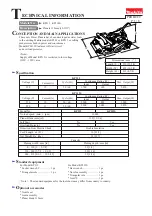
Tel: 886.2.2175 2930 Email: [email protected]
15
Connect the oscilloscope with PC, iOS or Android
1)
Connect with PC via USB cable or Wi-Fi. Please refer to
2)
Connect with IOS via Wi-Fi. Please refer to
3)
Connect with Android via Wi-Fi. Please refer to
Input a signal to a channel of the oscilloscope
The oscilloscope is equipped with two channels plus external trigger.
Please input signal in the following steps:
1)
Set the attenuation switch on the probe as 10X and connect the probe on the oscilloscope with CH1. Aim the
slot in the probe connector at the faucet on BNC of CH1 and insert, then, turn right to lock the probe. Finally,
attach the tip of probe and ground nip to the Connector of Probe compensator.
2)
Set the CH1 probe attenuation of the oscilloscope to X10. (The default is X1).
3)
Attach the tip of probe and ground nip to the Connector of Probe compensator. Click the AUTO button. A square
wave will be displayed within a several seconds. (Approximately 1 KHz, 2V, peak- to- peak).
4)
Inspect CH2 with the same method. Repeat steps 2 and 3.
3.7
Self Calibration
The self calibration routine lets you optimize the oscilloscope signal path for maximum measurement accuracy. You
can run the routine at any time but you should always run the routine if the ambient temperature changes by 5
℃
or
more. For accurate calibration, power on the oscilloscope and wait twenty minutes to ensure it is warmed up. To
compensate the signal path, disconnect any probes or cables from the input connectors. Then, access the “Utility ->
Calibrate/Self Calibration” option and follow the directions on the screen. The self calibration routine takes about
several minutes.
















































